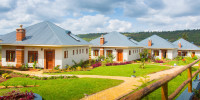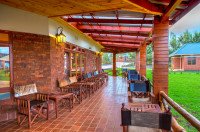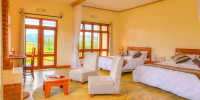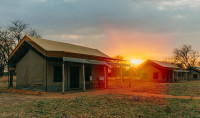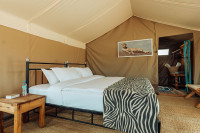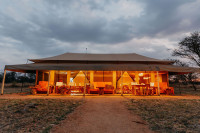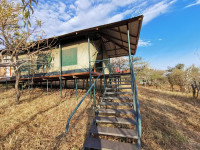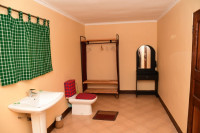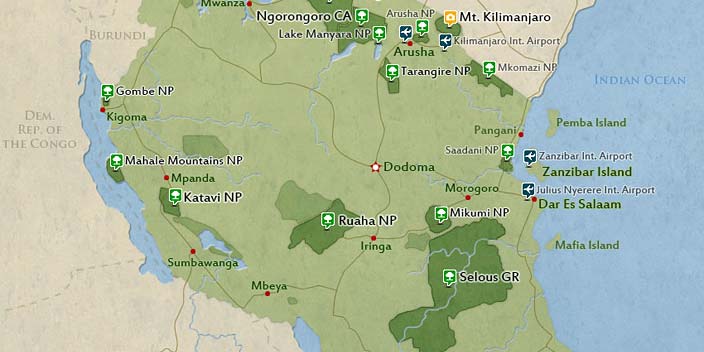
$1,593 pp (USD)
2 travelers on Start dateArrival
Arrival

Day 1
Arusha to Tarangire National Park
Arusha to Tarangire National Park
On the first day, we'll pick you up from Arusha or Kilimanjaro Airport, or from your hotel in the area. As we embark on the scenic 2.5-hour drive, you'll enjoy the stunning landscapes and nature along the way. Upon reaching Tarangire National Park, we'll start with an exciting morning game drive, followed by a picnic lunch at a scenic spot. In the afternoon, we'll continue exploring the park on another game drive.
Located 115 km south of Arusha, Tarangire is a long and narrow park covering 2,850 sq km, stretching along the Tarangire River. The park is named after the river, which serves as the vital water source for wildlife during the dry season. Tarangire is renowned for its large elephant herds, iconic baobab trees, and the elusive tree-climbing African pythons. During the dry months, the concentration of animals around the river is as impressive as that of the Ngorongoro Crater.
- Main Destination:
- Tarangire National Park
- Accommodation:
- Marera Valley Lodge
- Meals & Drinks:

Day 2
Lake Manyara National Park
Lake Manyara National Park
In the morning, we’ll set off towards Lake Manyara for a full day of game viewing. Known for its stunning panoramic vistas, tranquil waterfalls, babbling brooks, and hot springs, Lake Manyara National Park offers a rich diversity of landscapes. Nestled between the towering cliffs of the Great Rift Valley and the lake itself, this park is a true gem.
The park is home to a vast array of wildlife, including large herds of elephants, giraffes, hippos, buffalo, and impalas. Lake Manyara also boasts one of the largest populations of water birds, with over 400 species, including flamingos and pelicans, making it a birdwatcher’s paradise.
As we explore the park’s varied ecosystems—ranging from grassy plains to lush forests and sparkling waters—you’ll witness the rich biodiversity that makes this area so unique. In the late afternoon, we’ll arrive at your lodge, where you can unwind before enjoying a delicious dinner and settling in for an overnight stay.
- Main Destination:
- Lake Manyara National Park
- Accommodation:
- Marera Valley Lodge
- Meals & Drinks:

Day 3
Serengeti National Park
Serengeti National Park
After breakfast, we’ll set off towards the Serengeti, embarking on a scenic 4-hour drive. Once we arrive, we’ll enjoy a delicious lunch before heading out for an afternoon game drive in this iconic park. Known for its vast, endless plains of savannah and diverse forest landscapes, the Serengeti is world-renowned for the Great Migration, where around 1.5 million herbivores and their followers are on the move, driven by the drought in the northern hills as they make their way to the southern plains. After the rains in mid-April, they’ll circle back through the western part of the park.
As the day comes to a close, we’ll arrive at our campsite, located deep within the Serengeti. Your tent will be set up and ready, and in the evening, our chef will prepare a delicious dinner for you to enjoy under the stars.
- Main Destination:
- Serengeti National Park
- Accommodation:
- Kontiki Serengeti Camp
- Meals & Drinks:

Day 4
Serengeti to Ngorongoro Crater
Serengeti to Ngorongoro Crater
On day 4, we will do an early morning game drive in Serengeti. In the afternoon, we will be heading to Ngorongoro Conservation Area where we will have dinner and our overnight at Simba Campsite.
Today, we will get our first sight of the spectacular, incomparable Ngorongoro Crater, the world’s largest intact volcanic caldera and the heart of the Conservation Area of the same name. But before that, we will have another morning game drive in the amazing Serengeti, marveling at its animal inhabitants. It's another day of adventure, another day to enjoy wildlife.
- Main Destination:
- Serengeti National Park
- Accommodation:
- Ngorongoro Wild Camp
- Meals & Drinks:

Day 5
Ngorongoro Crater to Arusha
Ngorongoro Crater to Arusha
Descend to Ngorongoro caldera.
We have kept the best for the last day... After your breakfast with views to the crater your 4-wheel drive vehicle will take you 2000ft down to the crater.
The Ngorongoro Crater is the world's largest volcanic caldera at 8300sq km. It is frequently described as one of the wonders of the world. Not only because of its geological magnificence but also because it serves as an extraordinary natural sanctuary for some of Africa's largest populations of large mammals. After lunch, we will depart the park and initiate the return to Arusha or Arusha/Kilimanjaro Airport.
- Main Destination:
- Ngorongoro Crater
- Accommodation:
- No accommodation (End of tour)
- Meals & Drinks:
















